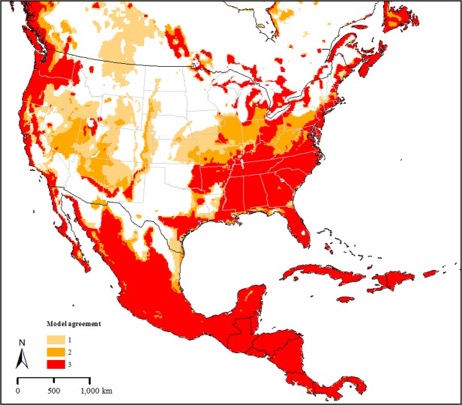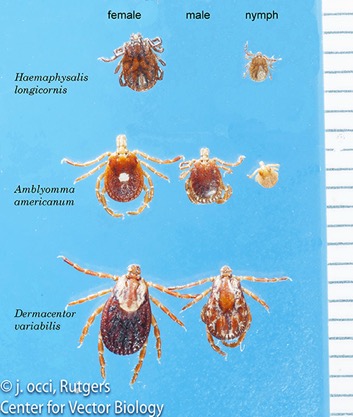
March 2019
Watch Out for the Newly Invaded Long-horned Tick This Season
By Dr. Ram Raghavan
A newly invading tick species, the long-horned tick (Haemaphysalis longicornis), may negatively affect cattle herds and companion animals and could be spreading across the United States and into the Midwest this year.

|
| Figure 1. Predicted suitable areas for long-horned tick, Haemaphysalis longicornis across North America. 1, 2, and 3 represent areas that were predicted to be suitable for the establishment of H. longicornis in North America by one, two and three models, respectively. Darker areas represent progressively higher agreement between the models. © Nature Scientific Report 2019. |
I recently published a predictive model in Nature Scientific Reports that indicates these ticks could establish in the eastern parts of Kansas and neighboring states if they manage to get here. (Figure 1) At present, the ticks have been found primarily in the eastern United States, although they were also found in Arkansas in 2018. Because cattle and companion animal movement across the U.S. is common, it may only be a matter of time before these ticks show up in Kansas.
The long-horned tick is capable of carrying several pathogens and they have been implicated in the transmission of Theileria orientalis var. Ikeda and T. orientalis var. Chitose, blood parasites that cause bovine theileriosis, an economically significant disease in Australia and New Zealand. At present, it is not known if long-horned ticks in North America carry pathogens.
I conducted extensive fieldwork and laboratory studies this past summer in Queensland, Australia aimed at understanding the habitat requirements of long-horned ticks and the identification of its different life-stages based on morphological characters. These ticks are similar in appearance to many of the local ticks and it will require experts to correctly identify them. (Figure 2)
KSVDL can identify these ticks if they are sent in an air-tight, sealed container. Ticks need not be stored in alcohol for shipment. Please contact KSVDL at 866-512-5650 or clientcare@k-state.eduwith or Dr. Raghavan at 785-532-5618 for more information.
|
|
|
Figure 2. Adult and immature long-horned ticks and other common ticks in the Midwest. © Jim Occi, Rutgers University |
NEXT: Titers vs. PCR to Diagnose Leptospirosis Infection in Horses with ERU
Return to Index
